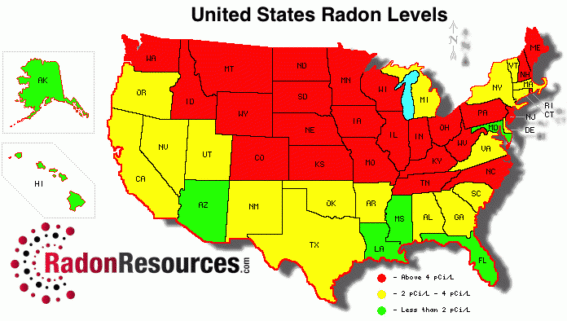Radon Gas: What you don’t know could kill you!
Most people spend the majority of their time at home so it’s important to have a home that is both comfortable and safe. While smoke detectors have been a staple in American homes for years and carbon monoxide alarms have been required in any home built after July 1, 2008, there’s another highly dangerous, extremely common danger that many homeowners ignore: Radon gas.
While many people know of radon gas and the potential dangers associated with it, many have never heard of it until they’re ready to buy or sell a home. Natural levels of radon are highest in the majority of the Midwest and Plains state, but high radon levels can be found from Washington to North Carolina. Some state have laws that require a home seller or real estate agent to disclose any known radon information about a property, but no states have laws requiring the testing before the sale of a property. Whether you’re buying or selling a home (or just living in one!) here’s what you need to know!
What is Radon?
Radon is a cancer-causing radioactive gas that you can’t see, smell, or taste. By breathing in radon, you’re increasing your chances of lung cancer. In fact, radon is the second leading cause of lung cancer in the US, causng 21, 000 deaths each year.
Where does it come from?
Radon gas is a product of the natural breakdown of uranium in soil, rock, and water. Typically it moves up through the ground to the air above and into homes through cracks and other holes in the foundation, but it can also enter through well water.
Who should test?
Everyone. Homes all over the US have been found with radon issues and the US Surgeon General suggests testing all homes below the third floor for radon. There are two versions of the test, a long one which spans more than 90 days and a shorter version that can be completed in 2-90 days. You can find professional to conduct the test for you or there are simple kits to test as well. If you’re planning to do the testing yourself, make sure you buy a kit that includes the lab testing in the price or you’ll have to pay another fee to have it processed.
I have a new home, I’m safe, right?
Nope. All homes should be tested. Whether your home is old and draft or new and airtight, this gas can slip in and do its damage to your air quality. Nearly 1 in 15 homes in the US is estimated to have elevated radon levels above 4 pCi/L (picocuries per liter) which is the Environmental Protection Agency considers to be a high-risk level of exposure.
I’m selling my home. What should I do?
Some states require disclosure of any known radon testing results. A potential buyer may ask for a new test if the EPA’s Radon Testing Checklist items were not met, the last test took place more than two years prior, you have renovated or altered your home since the test, or the buyer plans to use a lower level than you tested such as a basement. States that require disclosure of previous test findings include: Alaska, Arizona, Delaware, Florida, Illinois, Kanas, Maryland, Mine, Michigan, Minnesota, Montana, North Carolina, New Hampshire, New York, Ohio, Oregon, Rhode Island, South Carolina, South Dakota, Tennessee, Texas, Washington, and Wisconsin. More information about laws regarding testing and disclosures can be found here.
I’m buying a home. Should I ask for a test?
It’s always a good idea to ask for a test if possible. If there has been a previous test done you can accept the results of prior radon tests or ask the seller to perform a new one to be conducted by a qualified tester. Before accepting previous results, keep in mind that results can differ based on who conducted the test, where in the home the test was conducted, and if any structural changes occurred since the test.
I found high radon levels. What do I do now?
There are a variety of methods to reduce radon in your home. The most basic approach begins with sealing cracks and other holes in the foundation, but the EPA recommends taking it a step further with a vent piper and/or fan solution. Often referred to as a “sub-slab depressurization system” these do not require major changes to your home and can help prevent radon gas from entering your home from below the floor/foundation. Radon mitigation specialists will be able to help you find the best solution based on the design of your home and other factors.
Radon Protection: How Homebuyers can do Their Due Diligence
A home purchase is one of the most significant transactions people go through in their lives. This guide will discuss radon’s natural presence in a home, acceptable radon levels, what protections are available, ways in which a radon issue may be resolved and how to reduce radon levels in a home. Get the guide here.
For more information you can read the EPA’s full Home Buyer’s and Seller’s Guide to Radon here.
- 20 Trends from the 1920’s to Watch in 2023 - March 24, 2023
- How much does a real estate agent make? - September 4, 2020
- 5 Things Real Estate Agents Don’t Want You to Know - July 17, 2020




Leave a Reply
Want to join the discussion?Feel free to contribute!